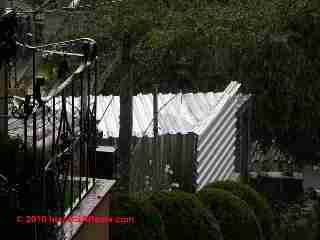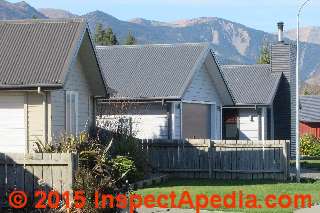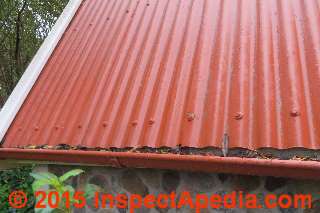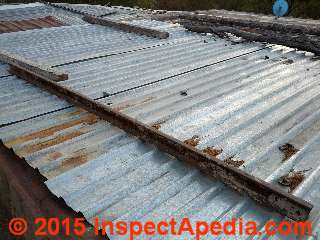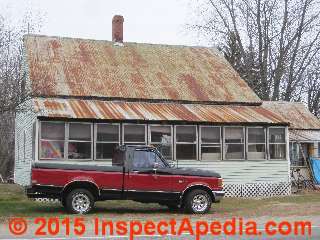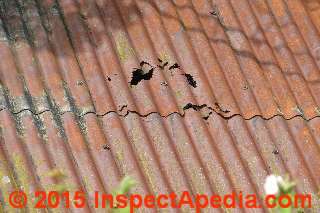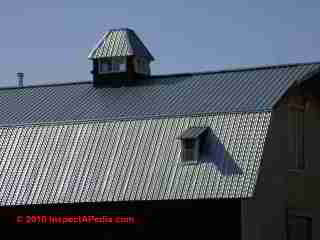 Galvanized & Coated Metal Roofing Types
Galvanized & Coated Metal Roofing Types
Metal Roof Examples, Product Sources, Installation, Defects, Repairs
- POST a QUESTION or COMMENT about galvanized metal roofs
Corrugated metal & formed galvanized steel roofing products:
This article describes galvanized metal roofing products and metals: metal roof choices, installation, inspection, metal roof defects, roofing repairs, and metal roof product sources. Page top photo: galvanized steel ribbed roofing on a barn in Dutchess County, New York.
InspectAPedia tolerates no conflicts of interest. We have no relationship with advertisers, products, or services discussed at this website.
- Daniel Friedman, Publisher/Editor/Author - See WHO ARE WE?
Galvanized Metal Roofing Materials, Choices, Costs, Life Expectancy, Characteristics
Galvanized iron or steel roofing - according to the US NPS, "Iron or steel are galvanized by coating them with zinc.
Our metal roof photo (above left) shows galvanized steel metal roofing used on both roof and the side of a small building in San Miguel de Allende. Below a galvanized steel roof in Lourdes, also in Mexico, illustrates the worldwide appeal of this comparatively inexpensive roof covering material. In areas not located in high wind zones this roofing is often installed using anything at hand as a roof weight or fastener.
[Click to enlarge any image]
Shown below at left, coated steel roofing on buildings in Hamner Springs on the South Island in New Zealand.
Our second New Zealand metal roof, from on St. Cuthberts church in Port Hills in Christchurch, illustrates the traditional screw fastener method of attaching the roof to its sheathing or lath. St. Cuthberts, built in 1874, has suffered extensive earthquake damage and is not currently in use.
Rather than producing the simple coating created by tinplating, a rust resistant alloy of the two metals forms on the surface.
In 1839, two years after galvanizing was patented in Europe, the material was used on the roof of the Merchants Exchange in Manhattan.
To protect against corrosion, the steel is bonded to a layer of zinc, which works as a sacrificial coating on the surface and also offers some protection to cut edges and nicks by flowing to these areas.
The heavier the zinc coating, the longer the protection. The Metal Roofing Alliance recommends G-90 galvanized steel for roofing, which has 90 ounces of zinc per square foot.
Unpainted G-90 galvanized steel is typically warranted against corrosion for 20 years under normal conditions. It often lasts longer, but it may show visible corrosion in as few five years under harsh conditions, such as salt spray, significant air pollution, or low-slope applications in wet climates. Field cuts made with an abrasive saw are prone to corrosion.
Though the sheet iron was hand dipped in the zinc, much as it was in tin, larger sheets were used (24 by 72 inches in the 1850s). This meant fewer joints, and when used as corrugated sheets, less supporting framing.
The rather rusty galvanized metal roof shown above is on a home in Portland, Maine in the U.S.
Below is an example of a rusted-through galvanized steel roof at Garway Hill, St. Weonards, in Herefordshire, U.K.
Even as the production of galvanized iron and steel roofing products increased, the price remained higher than that of other metals. The price differential did not shrink sufficiently for galvanized roofing to exceed tin and terneplate in popularity until the 20th century. "
Iron and steel roofing
according to the US NPS, "Both iron and steel without any plating were used for roofing. The Philadelphia home of the mill owner who rolled the first sheet iron in the United States was roofed in the material around 1794.
Iron replaced slate on the White House in 1804. Because it was available in large sheets, rather than the small sheets used for plated material, it required fewer joints.
Some manufacturers produced factory painted material, but late19th century accounts indicate that paint was an inadequate defense against the corrosive effects of the atmosphere in industrial regions."
The rusted corrugated galvanized steel roof shown above was installed about 40 years ago at Brinstone Farm in St. Weonards in Herefordshire in the U.K. This roof replaced a worn-out corrugated cement asbestos roof on the same barn buildings.
Galvalume®: Metal Roof Products Similar to Galvanized Roofing
Aluminized steel generally outlasts galvanized steel but has largely been replaced in the market by Galvalume®.
Also sold under the trade names Zincalume ® and Galval®, Galvalume® was developed in the early 1970s. The underlying steel is coated with a zinc aluminum alloy that combines the long-lasting protection of aluminum with the self-healing properties of zinc.
It also has the reflective qualities of aluminum, reducing attic temperatures and cooling loads. The most common application weight is AZ 55, which has about a 1-mil-thick coating on each side. Unpainted Galvalume® is warranted against corrosion for 20 years, but it has stood up well in weathering tests for 30 years and is projected to last up to 40 years under normal conditions.
Cut edges hold up very well, but cutting the material with an abrasive blade is discouraged as the filings will mar the surface. Galvalume® costs about 10% more than standard galvanized steel.
Steel metal roofing, including Galvalume Metal Roofing. Quoting from the Metal Roof Alliance:
Galvalume steel is an ideal roofing material because of its strength, extraordinary outdoor corrosion resistance and longevity. Steel roofing used in residential applications today is metallic coated with either Zinc (G90) or Zinc/Aluminum (AZ50) to provide the corrosion resistance homeowners desire.
Steel roofing is strong and therefore gives higher wind uplift resistance and a broader range of application than other roofing materials.
As a result, an installed steel roof system has a broader range of price levels and products than many other kinds of metal roofing. Steel roofs have passed the UL 90 wind tests due to their strength and weight. For additional test results, visit www.fsec.ucf.edu to view the reports done at FL Solar Energy Center in their Flexible Roofing Facility.
Steel Roof ShingleToday's quality steel roofing offers excellent rust protection as well. Galvanized steel roofing is available painted, aggregate-coated, or with a mill or bare finish. Unlike conventional non-metallic roof systems, Galvalume steel roofs won't crack and peel when subjected to the sun and weather.
-- Adapted and expanded with permission from Best Practices Guide to Residential Construction (Steve Bliss, J Wiley & Sons) .
Also see ALUMINIZED STEEL ROOFS
Also see METALS USED IN ROOFING.
Metal Roofing Sources, Products, & Manufacturers
Best Practices Guide to Residential Construction lists these producers and sources of metal roofing, metal roof fastening systems, and related metal roofing products
- Classic Products, website:
www.classicroof.com
Modular metal shingle panels and standing seam panels - Decra Roofing Systems, website:
www.decra.com
Modular metal shingle, tile, and shake panels - Dura-Lok Roofing Systems, website:
www.duraloc.com
Modular metal roofing shingles with granular coating - Fabral, website:
www.fabral.com
Exposed fastener and concealed clip metal roofing panels - Follansbee Roofing, Follansbee WV 26037, Tel: 800-624-6906, website: www.follansbeeroofing.com - Terne II discussed at [1]
- Gerard Roofing Technologies, website:
www.gerardusa.com
Modular metal shake and tile panels with granular coating - Met-Tile, website:
www.met-tile.com
Modular metal roof-tile panels - Atas International, website:
www.atas.com
Modular metal shingle, tile, and standing-seam panels - Custom-Bilt Metals, website:
www.custombiltmetals.com
Modular metal shakes and standing seam panels
- - Portions of this article were adapted with permission from Best Practices Guide to Residential Construction (Steve Bliss, J Wiley & Sons) .
...
Continue reading at GALVANIC SCALE & METAL CORROSION or select a topic from the closely-related articles below, or see the complete ARTICLE INDEX.
Or see these
Recommended Articles
- CORRUGATED ROOFING
- GALVALUME METAL ROOFS
- GALVANIZED STEEL ROOFS
- METAL ROOFING - home
- METALS USED IN ROOFING
- STEEL & IRON BUILDING SIDING
Suggested citation for this web page
GALVANIZED STEEL ROOFS at InspectApedia.com - online encyclopedia of building & environmental inspection, testing, diagnosis, repair, & problem prevention advice.
Or see this
INDEX to RELATED ARTICLES: ARTICLE INDEX to BUILDING ROOFING
Or use the SEARCH BOX found below to Ask a Question or Search InspectApedia
Ask a Question or Search InspectApedia
Try the search box just below, or if you prefer, post a question or comment in the Comments box below and we will respond promptly.
Search the InspectApedia website
Note: appearance of your Comment below may be delayed: if your comment contains an image, photograph, web link, or text that looks to the software as if it might be a web link, your posting will appear after it has been approved by a moderator. Apologies for the delay.
Only one image can be added per comment but you can post as many comments, and therefore images, as you like.
You will not receive a notification when a response to your question has been posted.
Please bookmark this page to make it easy for you to check back for our response.
IF above you see "Comment Form is loading comments..." then COMMENT BOX - countable.ca / bawkbox.com IS NOT WORKING.
In any case you are welcome to send an email directly to us at InspectApedia.com at editor@inspectApedia.com
We'll reply to you directly. Please help us help you by noting, in your email, the URL of the InspectApedia page where you wanted to comment.
Citations & References
In addition to any citations in the article above, a full list is available on request.
- "Choosing Roofing," Jefferson Kolle, January 1995, No. 92, Fine Homebuilding, Taunton Press, 63 S. Main St., PO Box 5506, Newton CT 06470 - 800-888-8286 - see http://www.taunton.com/FineHomebuilding/ for the magazine's website and for subscription information.
- [1] Follansbee Roofing, Follansbee WV 26037, Tel: 800-624-6906, website: www.follansbeeroofing.com and http://www.follansbeeroofing.com/products/TerneII.aspx Quoting Follansbee on TerneII properties:
Follansbee Steel is the only manufacturer of a pre-painted or natural Terne roof and is a leading supplier of metal roofs for new and retrofit commercial, institutional, residential and historic preservation projects.Terne II - Classic Terne-Coated Steel ... is a new and improved version of historic Terne metal, ... Terne II has improved capability for resisting corrosion in all environments ... also has excellent formability, solderability, and affinity for paint ... without compromising mechanical characteristics. It can be used in flatlock, standing seam, vertical wall designs and virtually any other application in which original Terne has been used. It is strong and ductile, having high yield and tensile strengths as well as workability. This new material can easily be formed with conventional roofing tools.
With Terne II roofing, it is advisable to paint the material as soon as conditions permit. Oxide formation is slower than with the original Terne and the wait for proper painting conditions provides substantially less risk. The new material is coated with Follansbee's new ZT® alloy, a combination of zinc and tin. This coating is designed not only as a barrier but also to be anodic to the steel substrate and reduce the potential for oxidation before painting.
The traditional oil-based paints long required on original Terne are not recommended for application on Terne II. Follansbee's Rapidri paint with its faster drying time and ease of application is much superior to the old painting system. The Rapidri acrylic paints are aesthetically pleasing while offering enhanced durability and color retention. ...
- Metal Roofing Alliance, E. 4142 Hwy 302, Belfair, WA 98528, Telephone:(360) 275-6164, Customer Support 410-534-6900, Email: support@metalroofing.com,
Website: www.metalroofing.com. Quoting:
The Metal Roofing Alliance was formed in 1998 by a small group of forward-thinking metal roofing manufacturers with the main goal of educating consumers about the many benefits of metal roofing. Since our inception, we've shown millions of people just how beautiful, durable and money-saving metal roofing can be for them. Over the years, our membership has grown to include paint companies, material suppliers, industry publications and more. Be sure to take advantage of all of the great resources our members offer. - The Metal Initiative, 4700 W. Lake Ave., Glenview, IL 60025, P:847.375.4785 Website: www.themetalinitiative.com/, Email: Louise Ristau lristau@connect2amc.com Quoting:
The Metal Initiative is a coalition of manufacturers, individuals and associations that have come together to provide information on the features and benefits of metal in construction. Carrying its message of metal primarily to the professional building owner community, The Metal Initiative seeks to gather and disseminate useful information for decision-makers. - Metal Roofing, an Illustrated Guide, R.A. Knowlton , [metal shingle roofs],
- Problems in Roofing Design, B. Harrison McCampbell, Butterworth Heineman, 1991 ISBN 0-7506-9162-X (available used)
- Grapevine Design Guidelines - Web Search 07/12/2010
- NPS, FROM ASBESTOS TO ZINC, ROOFING FOR HISTORIC BUILDINGS, METALS [PDF] chnical Preservation Services, National Park Service, U.S. Department of the Interior, web search 9/29/2010, original source: nps.gov/history/hps/tps/roofingexhibit/metals2.htm
- NPS, FROM ASBESTOS TO ZINC, ROOFING FOR HISTORIC BUILDINGS, METALS-PART II, Coated Ferrous Metals: Iron, Lead, Zinc, Tin, Terne, Galvanized, Enameled Roofs [PDF] Technical Preservation Services, National Park Service, U.S. Department of the Interior, web search 9/29/2010, original source: nps.gov/history/hps/tps/roofingexhibit/metals.htm
- NPS, FROM ASBESTOS TO ZINC, ROOFING FOR HISTORIC BUILDINGS, METALS- ROOFING TODAY [PDF] Technical Preservation Services, National Park Service, U.S. Department of the Interior, web search 9/29/2010, original source: nps.gov/history/hps/tps/roofingexhibit/roofingtoday.htm
- Sweetser, Sarah M., ROOFING for HISTORIC BUILDINGS [PDF] (1978) Preservation Brief 4, Technical Preservation Services, National Park Service, U.S. Department of the Interior, web search 9./29.10, original source: http://www.nps.gov/history/hps/tps/briefs/brief04.htm
- Park, Sharon C., AIA, THE USE OF SUBSTITUTE MATERIALS ON HISTORIC BUILDING EXTERIORS [PDF] Preservation Brief 16, Technical Preservation Services, National Park Service, U.S. Department of the Interior, web search 9./29.10, original source:
http://www.nps.gov/history/hps/tps/briefs/brief16.htm - ARMA - Asphalt Roofing Manufacturer's Association - Asphalt Roofing Manufacturer's Association - https://www.asphaltroofing.org/
750 National Press Building, 529 14th Street, NW, Washington, DC 20045, Tel: 202 / 207-0917 - NRCA, Smith, Thomas L., AIA, CRC, METAL ROOFING: 'FIXING' FOR THERMAL MOVEMENT [PDF] Professional Roofing, [date pending] p. 72, NRCA - Web: http://www.nrca.net/
- NRCA, Smith, Thomas L., AIA, CRC, METAL ROOF SYSTEMS: DESIGN CONSIDERATIONS FOR SNOW AND ICE [PDF] Professional Roofing, [date pending] p. 74, NRCA, http://www.nrca.net/
- NRCA, Smith, Thomas L., AIA, CRC, STEEL [ROOF] DECK CORROSION BULLETIN [PDF] Professional Roofing, [date pending] p. 58, NRCA, http://www.nrca.net/
- "Steel [Roof] Deck Corrosion Bulletin, NRCA [ copy on file as /roof/Steel_Roof_Deck_Corrosion_NRCA.pdf ] - ", Thomas L. Smith, AIA, CRC., Professional Roofing, [date pending] p. 58, NRCA
- NRCA, Smith, Thomas L., AIA, CRC, THE MANY ASPECTS of METAL [ROOF] SHINGLES [PDF] Professional Roofing, [date pending] NRCA, Web: nrca.net
- Cedar Shake & Shingle Bureau, CSSB, U.S.: Sumas, WA 98295-1178, Tel: 604-820-7700, In Canada: Cedar Shake and Shingle Bureau #2 - 7101 Horne Street, Mission, BC V2V 7A2 Tel: (604) 820-7700, E-mail: info@cedarbureau.com , Web: http://www.cedarbureau.org/
- U.S. Forest Products Laboratory, US FPL, One Gifford Pinchot Drive, Madison, WI 53726, Tel: (608) 231-9200, Email: mailroom_forest_products_laboratory@fs.fed.us608-231-9200, website: http://www.fpl.fs.fed.us/
- NRCA - National Roofing Contractors Association - Website: www.nrca.net 10255 W. Higgins Road, Suite 600, Rosemont, IL 60018-5607, Tel: (847) 299-9070
- Our recommended books about building & mechanical systems design, inspection, problem diagnosis, and repair, and about indoor environment and IAQ testing, diagnosis, and cleanup are at the InspectAPedia Bookstore. Also see our Book Reviews - InspectAPedia.
- Best Practices Guide to Residential Construction, by Steven Bliss. John Wiley & Sons, 2006. ISBN-10: 0471648361, ISBN-13: 978-0471648369, Hardcover: 320 pages, available from Amazon.com and also Wiley.com. See our book review of this publication.
- Decks and Porches, the JLC Guide to, Best Practices for Outdoor Spaces, Steve Bliss (Editor), The Journal of Light Construction, Williston VT, 2010 ISBN 10: 1-928580-42-4, ISBN 13: 978-1-928580-42-3, available from Amazon.com
- The Journal of Light Construction has generously given reprint permission to InspectAPedia.com for this article. All rights and contents are ©Journal of Light Construction and may not be reproduced in any form.
- Asphalt Roofing Residential Manual from ARMA the Asphalt Roofing Manufacturers Association Website https://www.asphaltroofing.org/product/residential-asphalt-roofing-manual/ ,
- Building Pathology, Deterioration, Diagnostics, and Intervention, Samuel Y. Harris, P.E., AIA, Esq., ISBN 0-471-33172-4, John Wiley & Sons, 2001 [General building science-DF] ISBN-10: 0471331724 ISBN-13: 978-0471331728
- Building Pathology: Principles and Practice, David Watt, Wiley-Blackwell; 2 edition (March 7, 2008) ISBN-10: 1405161035 ISBN-13: 978-1405161039
- Problems in Roofing Design, B. Harrison McCampbell, Butterworth Heineman, 1991 ISBN 0-7506-9162-X (available used)
- Roofing The Right Way, Steven Bolt, McGraw-Hill Professional; 3rd Ed (1996), ISBN-10: 0070066507, ISBN-13: 978-0070066502
- In addition to citations & references found in this article, see the research citations given at the end of the related articles found at our suggested
CONTINUE READING or RECOMMENDED ARTICLES.
- Carson, Dunlop & Associates Ltd., 120 Carlton Street Suite 407, Toronto ON M5A 4K2. Tel: (416) 964-9415 1-800-268-7070 Email: info@carsondunlop.com. Alan Carson is a past president of ASHI, the American Society of Home Inspectors.
Thanks to Alan Carson and Bob Dunlop, for permission for InspectAPedia to use text excerpts from The HOME REFERENCE BOOK - the Encyclopedia of Homes and to use illustrations from The ILLUSTRATED HOME .
Carson Dunlop Associates provides extensive home inspection education and report writing material. In gratitude we provide links to tsome Carson Dunlop Associates products and services.


